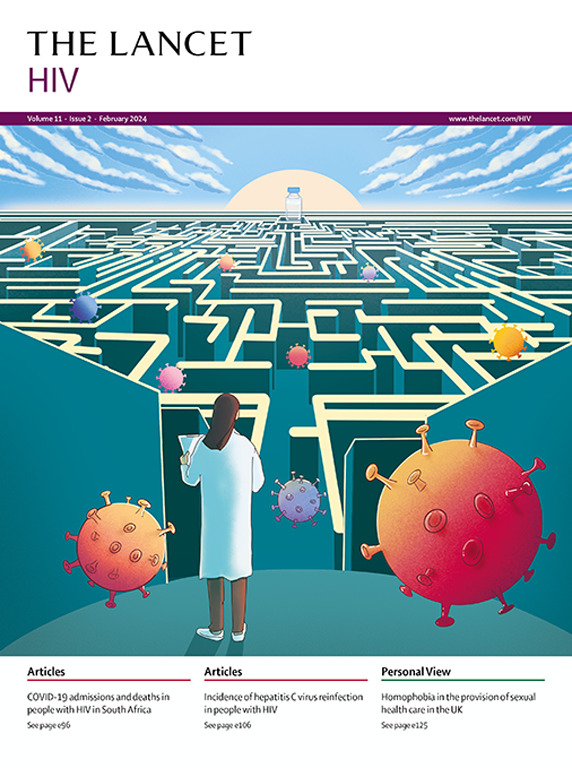Progress in the HIV response in Uganda: findings from two sequential population-based HIV impact assessment surveys, 2017-21.
IF 13
1区 医学
Q1 IMMUNOLOGY
引用次数: 0
Abstract
BACKGROUND Uganda has experienced a severe HIV epidemic and has endeavoured to implement HIV programmes to confront it. We assessed progress in the Ugandan response by comparing data from two sequential Uganda Population-based HIV Impact Assessments (UPHIAs) conducted in 2017 and 2021. METHODS The UPHIA was a nationally representative, cross-sectional survey using two-stage, stratified cluster sampling among adults aged 15-64 years (UPHIA 2017) or aged 15 years and older (UPHIA 2021) from all 11 regions of Uganda. Participants from randomly selected households provided demographic information and underwent HIV testing according to national guidelines, with laboratory confirmation of reactive results. We determined HIV-positive status awareness and antiretroviral therapy (ART) use through self-reporting or detection of antiretroviral drugs in blood samples. Viral suppression was defined as HIV-1 RNA of less than 1000 copies per mL. HIV incidence was estimated using a recent infection testing algorithm, and the incidence-to-prevalence ratio was calculated to assess epidemic dynamics, with lower values indicating progress towards epidemic control. We compared key indicators between surveys to evaluate progress towards the 95-95-95 targets and epidemic control. We applied Poisson regression models using survey weights and estimated variances using the Taylor series linearisation approach. FINDINGS 29 594 participants were enrolled in UPHIA 2017 and 23 898 participants were enrolled in UPHIA 2021. Overall HIV incidence decreased from 0·40% (95% CI 0·25-0·56) in 2017 to 0·30% (0·18-0·43) in 2021, although this change was not statistically significant (p=0·28). Among adults who tested positive for HIV, awareness of HIV status significantly improved from 72·5% (70·0-74·9) in 2017 to 80·8% (78·0-83·3) in 2021 (p<0·0001). Additionally, the proportion of participants on ART among those aware of their HIV status increased significantly from 90·4% (88·1-92·3) to 96·0% (94·3-97·2, p<0·0001), and the prevalence of viral suppression among those on ART also increased significantly from 83·7% (81·2-85·8) to 92·0% (90·1-93·5, p<0·0001). After adjusting for demographic covariates, adults living with HIV in 2021 were significantly more likely than those in 2017 to know their HIV status (adjusted prevalence ratio 1·09 [95% CI 1·05-1·14], p<0·0001), to be on ART if aware of their status (1·06 [1·03-1·09], p<0·0001), and to be virally suppressed if on ART (1·09 [1·05-1·14], p<0·0001). INTERPRETATION Uganda made substantial progress in its HIV response, with substantial improvements in HIV-positive awareness, ART coverage, and viral suppression. However, the absence of a statistically significant decrease in annual incidence or incidence-to-prevalence ratio and the fact that one-quarter of all people with HIV had unsuppressed viral load underscore the need for intensified testing, prevention, and treatment efforts to achieve a definitive epidemic transition. FUNDING The US President's Emergency Plan for AIDS Relief.乌干达艾滋病毒应对进展:2017-21年两次连续人口艾滋病毒影响评估调查的结果
背景:乌干达经历了严重的艾滋病毒流行病,并努力执行艾滋病毒方案来对付它。我们通过比较2017年和2021年两次连续的乌干达基于人口的艾滋病毒影响评估(UPHIAs)的数据,评估了乌干达应对工作的进展。UPHIA是一项具有全国代表性的横断面调查,采用两阶段分层整群抽样,对来自乌干达所有11个地区的15-64岁(UPHIA 2017)或15岁及以上(UPHIA 2021)的成年人进行调查。来自随机选择的家庭的参与者提供了人口统计信息,并根据国家指南接受了艾滋病毒检测,实验室确认了反应性结果。我们通过自我报告或检测血液样本中的抗逆转录病毒药物来确定hiv阳性状态意识和抗逆转录病毒治疗(ART)的使用。病毒抑制被定义为每毫升HIV-1 RNA少于1000拷贝。使用最近的感染检测算法估计HIV发病率,并计算发病率与患病率之比以评估流行动态,较低的值表明在流行病控制方面取得进展。我们比较了调查之间的关键指标,以评估95-95目标和流行病控制的进展情况。我们使用泊松回归模型使用调查权重和估计方差使用泰勒级数线性化方法。研究结果:29594名参与者入组了UPHIA 2017, 23898名参与者入组了UPHIA 2021。总体艾滋病毒感染率从2017年的0.40% (95% CI 0.25 - 0.56)下降到2021年的0.30%(0.18 - 0.43),尽管这一变化无统计学意义(p= 0.28)。在艾滋病毒检测呈阳性的成年人中,对艾滋病毒状况的认识从2017年的72.5%(70·0-74·9)显著提高到2021年的80.8%(78·0-83·3)(p< 0.0001)。此外,抗逆转录病毒治疗的参与者在知晓自己感染艾滋病毒的人群中所占比例从91.4%(88.1 - 92.3)显著增加到96.0% (93.4 - 92.7,p< 0.0001),抗逆转录病毒治疗人群中病毒抑制率也从83.7%(88.2 - 85.8)显著增加到92.5% (99.1 - 93.5,p< 0.0001)。在调整人口统计学协变量后,与2017年相比,2021年感染艾滋病毒的成年人更有可能知道自己的艾滋病毒状况(调整患病率比1.09 [95% CI 1.05 -1·14],p< 0.0001),如果知道自己的状况,更有可能接受抗逆转录病毒治疗(1.06[1.03 -1·09],p< 0.0001),如果接受抗逆转录病毒治疗,病毒受到抑制(1.09[1.05 -1·14],p< 0.0001)。乌干达在艾滋病毒应对方面取得了实质性进展,在艾滋病毒阳性意识、抗逆转录病毒治疗覆盖率和病毒抑制方面取得了实质性进展。然而,年发病率或发病率与流行率在统计上没有显著下降,而且四分之一的艾滋病毒感染者的病毒载量未受抑制,这突出表明需要加强检测、预防和治疗工作,以实现流行病的最终过渡。为美国总统艾滋病紧急救援计划提供资金。
本文章由计算机程序翻译,如有差异,请以英文原文为准。
求助全文
约1分钟内获得全文
求助全文
来源期刊

Lancet Hiv
IMMUNOLOGYINFECTIOUS DISEASES&-INFECTIOUS DISEASES
CiteScore
19.90
自引率
4.30%
发文量
368
期刊介绍:
The Lancet HIV is an internationally trusted source of clinical, public health, and global health knowledge with an Impact Factor of 16.1. It is dedicated to publishing original research, evidence-based reviews, and insightful features that advocate for change in or illuminates HIV clinical practice. The journal aims to provide a holistic view of the pandemic, covering clinical, epidemiological, and operational disciplines. It publishes content on innovative treatments and the biological research behind them, novel methods of service delivery, and new approaches to confronting HIV/AIDS worldwide. The Lancet HIV publishes various types of content including articles, reviews, comments, correspondences, and viewpoints. It also publishes series that aim to shape and drive positive change in clinical practice and health policy in areas of need in HIV. The journal is indexed by several abstracting and indexing services, including Crossref, Embase, Essential Science Indicators, MEDLINE, PubMed, SCIE and Scopus.
 求助内容:
求助内容: 应助结果提醒方式:
应助结果提醒方式:


